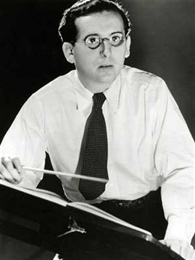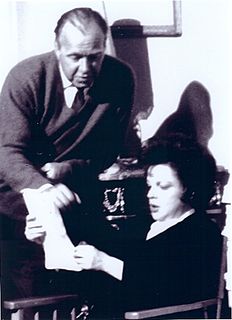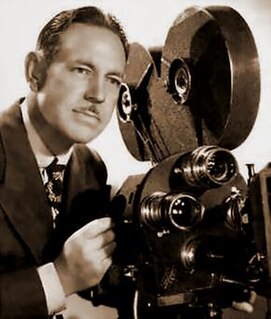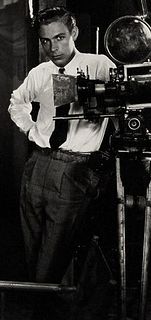Related Research Articles
The Academy Award for Best Animated Short Film is an award given by the Academy of Motion Picture Arts and Sciences (AMPAS) as part of the annual Academy Awards, or Oscars, since the 5th Academy Awards, covering the year 1931–32, to the present.
The Academy Award for Best Adapted Screenplay is the Academy Award for the best screenplay adapted from previously established material. The most frequently adapted media are novels, but other adapted narrative formats include stage plays, musicals, short stories, TV series, and even other films and film characters. All sequels are also considered adaptations by this standard.

Franz Waxman was a German-born composer and conductor of Jewish descent, known primarily for his work in the film music genre. His film scores include Bride of Frankenstein, Rebecca, Sunset Boulevard, A Place in the Sun, Stalag 17, Rear Window, Peyton Place, The Nun's Story, and Taras Bulba. He received twelve Academy Award nominations, and won two Oscars in consecutive years. He also received a Golden Globe Award for the former film. Bernard Herrmann said that the score for Taras Bulba was "the score of a lifetime."

Jerome Irving Wald was an American screenwriter and a producer of films and radio programs.

Ronald Neame CBE, BSC was an English film producer, director, cinematographer, and screenwriter. Beginning his career as a cinematographer, for his work on the British war film One of Our Aircraft Is Missing (1943) he received an Academy Award nomination for Best Special Effects. During a partnership with director David Lean, he produced Brief Encounter (1945), Great Expectations (1946), and Oliver Twist (1948), receiving two Academy Award nominations for writing.

Joseph LaShelle ASC was an American film cinematographer.

John Francis Seitz, A.S.C. was an American cinematographer and inventor.
Edward Anhalt was an American screenwriter, producer, and documentary filmmaker. After working as a journalist and documentary filmmaker for Pathé and CBS-TV, he teamed with his wife Edna Anhalt, one of his five wives, during World War II to write pulp fiction.
Joseph Francis Biroc, ASC was an American cinematographer. He was born in New York City and began working in films at the Paragon Studios in Fort Lee, New Jersey. After working there for approximately six years, he moved to Los Angeles. Once in Southern California, Biroc worked at the RKO Pictures movie studio. During World War II, he served in the U.S. Army Signal Corps, and filmed the Liberation of Paris in August 1944. In 1950, Biroc left RKO Pictures and freelanced on projects at various studios. In addition to his film work, which included It's a Wonderful Life (1946) and The Flight of the Phoenix (1965), Biroc worked on various television series, including the Adventures of Superman and Wonder Woman. He frequently collaborated with film director Robert Aldrich.

George Edward Bruns was an American composer of music for film and television. His accolades include four Academy Award nominations, and three Grammy Award nominations. He is mainly known for his compositions for numerous Disney films spanning from the 1950s until the 1970s, among them Sleeping Beauty (1959), One Hundred and One Dalmatians, The Absent-Minded Professor, The Sword in the Stone (1963), The Jungle Book (1967), The Love Bug (1968), The Aristocats (1970), and Robin Hood (1973).
Jack Martin Smith was a highly successful Hollywood art director with over 130 films to his credit and nine Academy Award nominations which ultimately yielded three Oscars.
Frederic Knudtson was an American film editor with 79 credits over his career, which spanned 1932 to 1964. He received six nominations for the Academy Award for Best Film Editing, including five in the six years preceding his death.
George Davis was an American art director and was the supervising art director at MGM from 1959 to 1970. He won two Academy Awards for Best Art Direction for his work on The Robe in 1954 and for The Diary of Anne Frank in 1960.
Lloyd Henry "Bummy" Bumstead was an American cinematic art director and production designer. In a career that spanned nearly 70 years, Bumstead began as a draftsman in RKO Pictures' art department and later served as an art director or production designer on more than 90 feature films. He won Academy Awards for Best Art Direction for To Kill a Mockingbird (1962) and The Sting (1973). He was also nominated for Academy Awards for his work on Vertigo (1958) and Unforgiven (1992).
Daniel J. Bloomberg was an Academy Award-winning audio engineer. Bloomberg's first Hollywood credit was in 1934, his last his Oscar-nominated work on John Ford’s The Quiet Man 18 years later. In the intervening time, he worked on several films in the Dick Tracy and Zorro series.
Russell Paul Carpenter, ASC is an American cinematographer and photographer, known for collaborating with directors James Cameron, Robert Luketic and McG. He won the Academy Award for Best Cinematography for the 1997 Best Picture-winning film Titanic. Much of his work been in blockbuster films, including Hard Target (1993), True Lies (1994), Charlie's Angels (2000) and its sequel Charlie's Angels: Full Throttle (2003), Ant-Man (2015) and XXX: Return of Xander Cage (2017). His documentary cinematography includes George Harrison: Living in the Material World, directed by Martin Scorsese. It earned six nominations at the 64th Primetime Emmy Awards, including Outstanding Cinematography for Nonfiction Programming for the cinematography team.
Gene Callahan was an American art director as well as set and production designer who contributed to over fifty films and more than a thousand TV episodes. He received nominations for the British Academy Film Award and four Oscars, including two wins.
George Wells was an American screenwriter and producer, best known for making light comedies and musicals for MGM.
Edward S. Haworth was an American production designer and art director. Active from 1950 to 1992, he was the production designer or art director on more than 50 feature films. He won an Academy Award for Best Art Direction for Sayonara (1957) and was nominated for the same award for five other films: Marty (1955), Some Like It Hot (1959), Pepe (1960), The Longest Day (1962), and 'What a Way to Go! (1964).

Edward Cronjager was an American cinematographer, whose career spanned from the silent era through the 1950s. He came from a family of cinematographers, with his father, uncle, and brother all working in the film industry behind the camera. His work covered over 100 films, and included projects on the small screen towards the end of his career. He filmed in both black and white and color mediums, and his work received nominations for seven Academy Awards over the span of three decades, although he never won the statue.
References
- ↑ "The 40th Academy Awards (1968) Nominees and Winners". oscars.org. Archived from the original on 3 November 2014. Retrieved 10 November 2011.